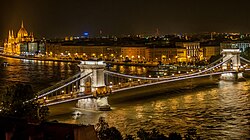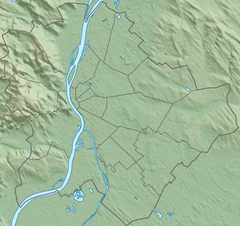Széchenyi Lánchíd
| Chain Bridge | |
|---|---|
 |
|
| Coordinates | 47°29′56″N 19°02′37″E / 47.49889°N 19.04361°ECoordinates: 47°29′56″N 19°02′37″E / 47.49889°N 19.04361°E |
| Carries | 2 road lanes |
| Crosses | Danube River |
| Locale | Budapest |
| Official name | Széchenyi Lánchíd |
| Other name(s) | Lánchíd |
| Characteristics | |
| Design | chain suspension bridge |
| Material | wrought iron and stone |
| Total length | 375 metres (1,230 ft) |
| Width | 14.8 metres (49 ft) |
| Longest span | 202 metres (663 ft) |
| History | |
| Designer | William Tierney Clark |
| Construction start | 1840 |
| Construction end | 1849 |
| Opened | November 20, 1849 |
The Széchenyi Chain Bridge (Hungarian: Széchenyi lánchíd, Hungarian pronunciation: [ˈseːt͡ʃeːɲi ˈlaːnt͡shiːd]) is a suspension bridge that spans the River Danube between Buda and Pest, the western and eastern sides of Budapest, the capital of Hungary. Designed by the English engineer William Tierney Clark and built by the Scottish engineer Adam Clark, it was the first permanent bridge across the Danube in Hungary. It was opened in 1849.
It is anchored on the Pest side of the river to Széchenyi (formerly Roosevelt) Square, adjacent to the Gresham Palace and the Hungarian Academy of Sciences, and on the Buda side to Adam Clark Square, near the Zero Kilometre Stone and the lower end of the Castle Hill Funicular, leading to Buda Castle.
The bridge has the name of István Széchenyi, a major supporter of its construction, attached to it, but is most commonly known as the "Chain Bridge". At the time of its construction, it was regarded as one of the modern world's engineering wonders. It has asserted an enormous significance in the country's economic, social and cultural life, much as the Brooklyn Bridge has in New York and United States of America. Its decorations made of cast iron, and its construction, radiating calm dignity and balance, have elevated the Chain Bridge to a high stature in Europe. It became a symbol of advancement, national awakening, and the linkage between East and West.
...
Wikipedia

